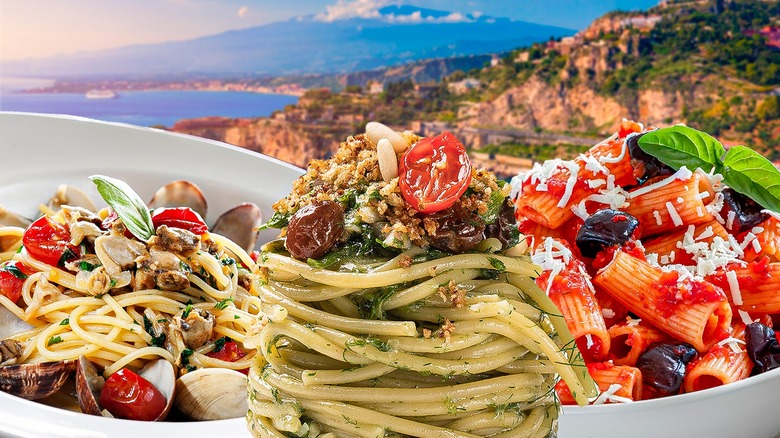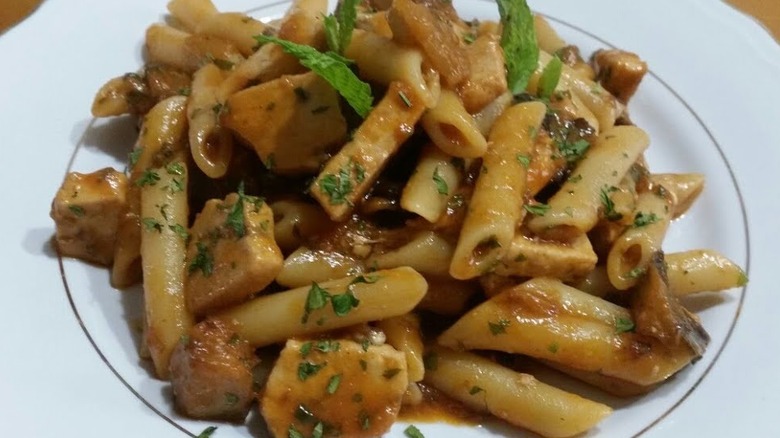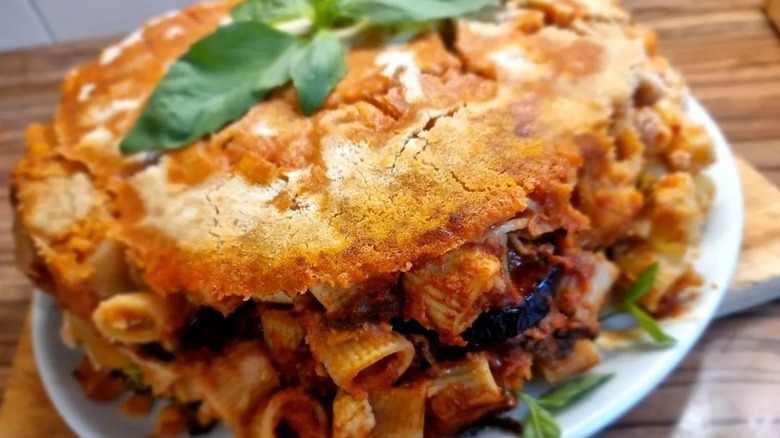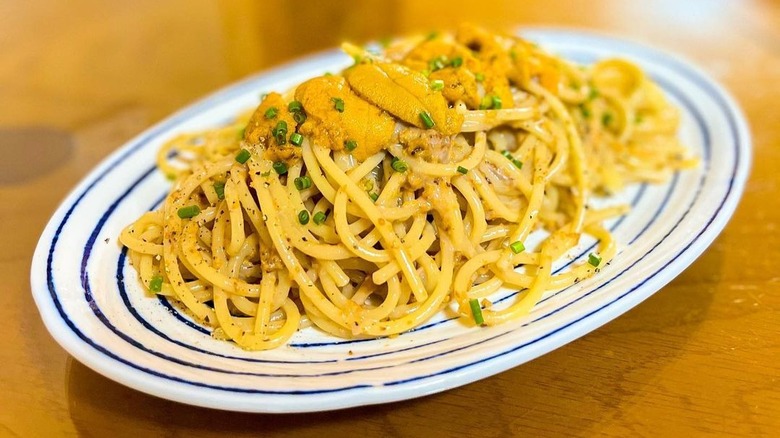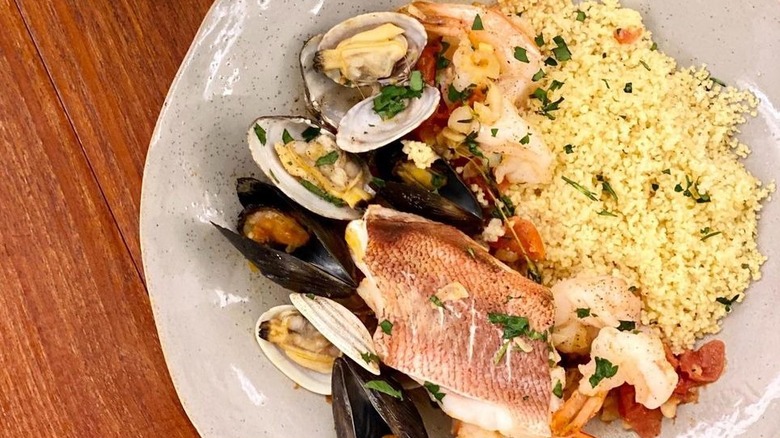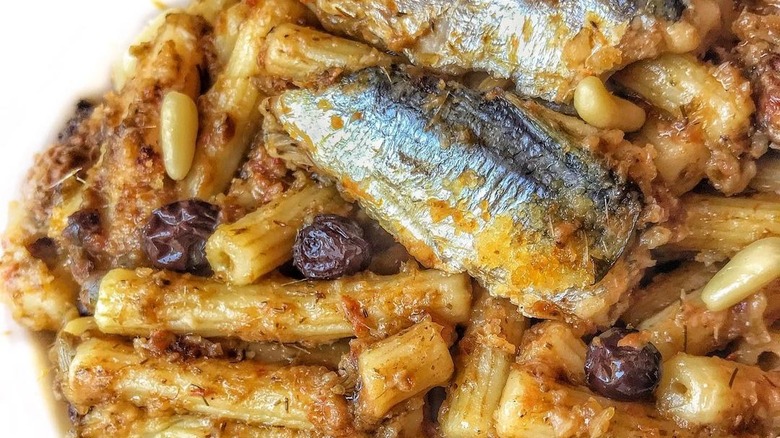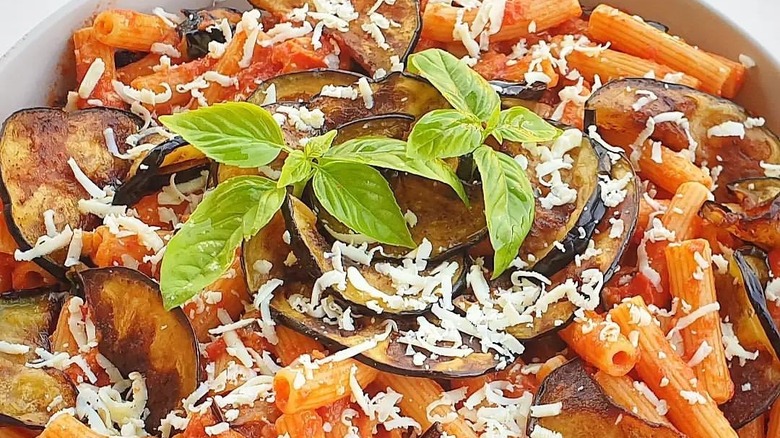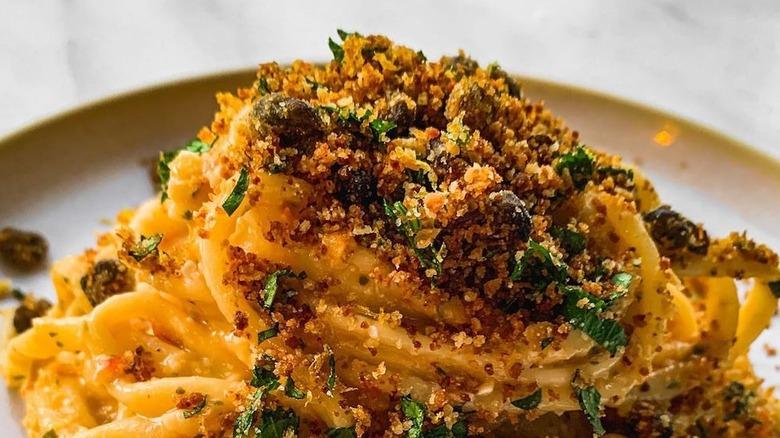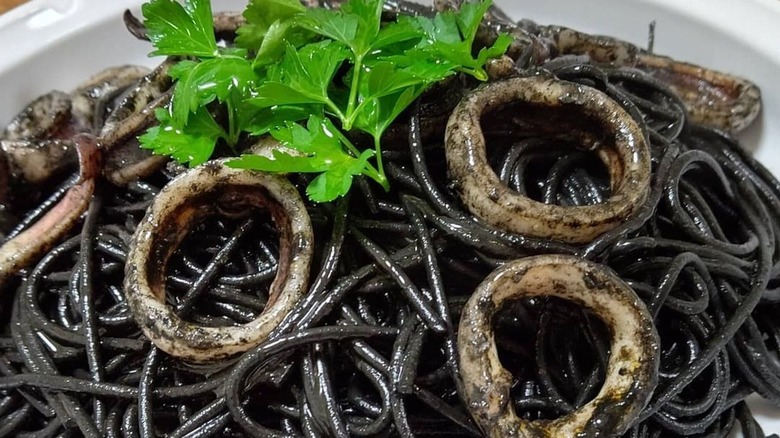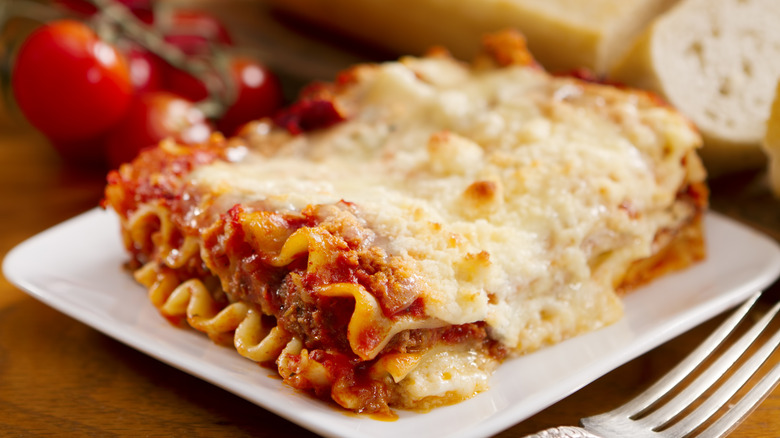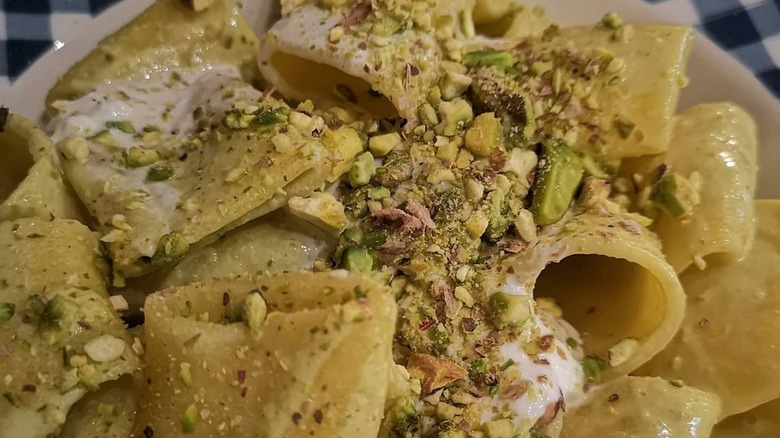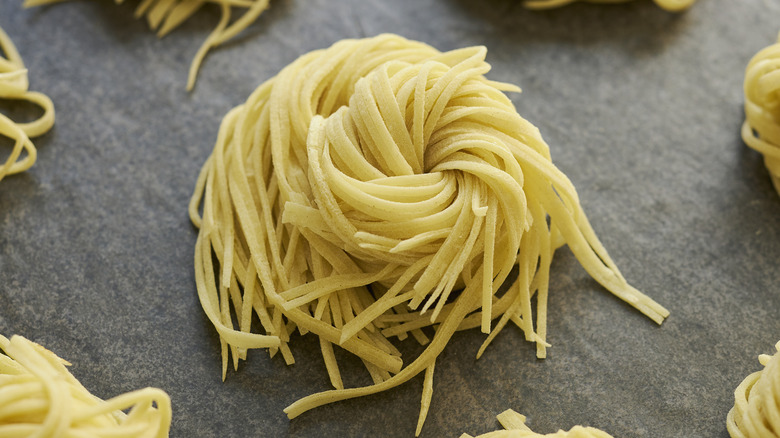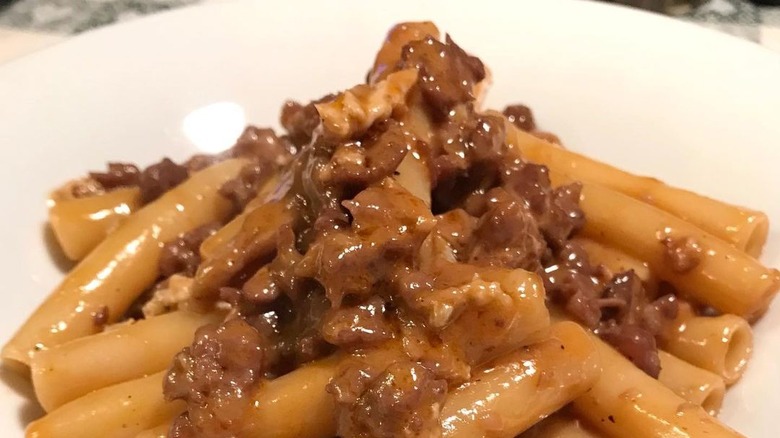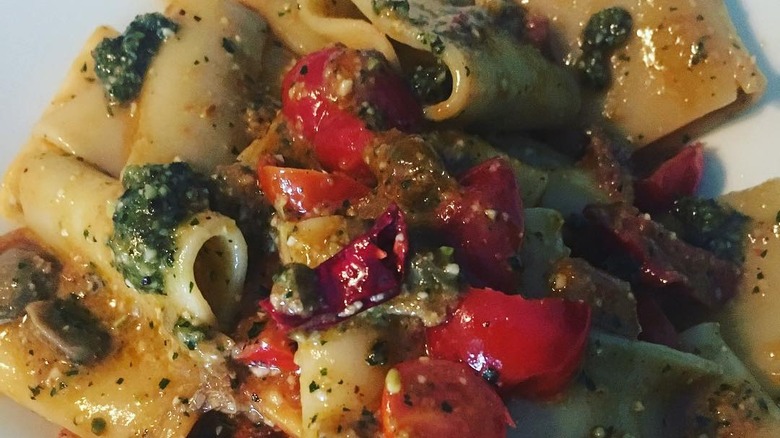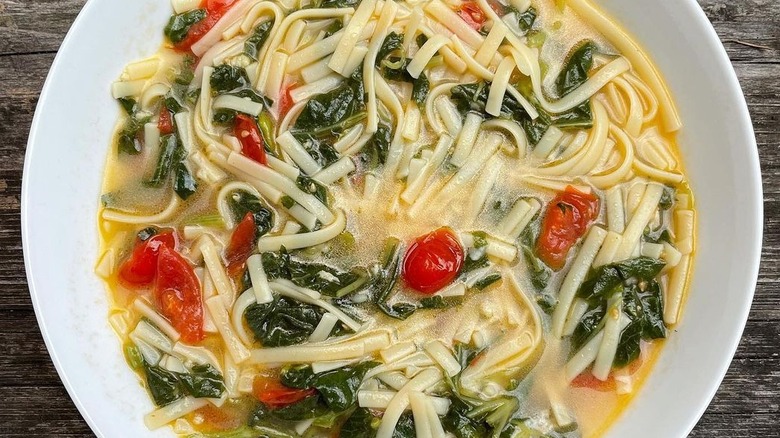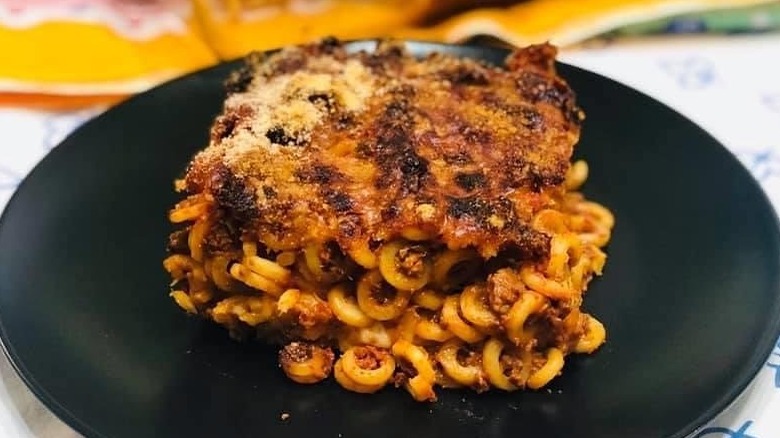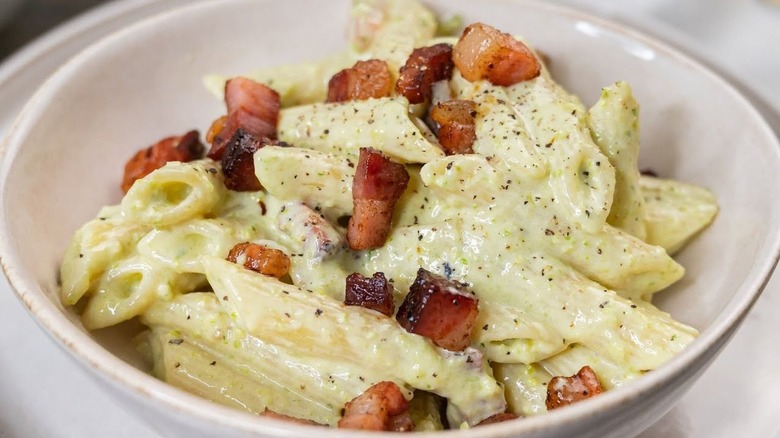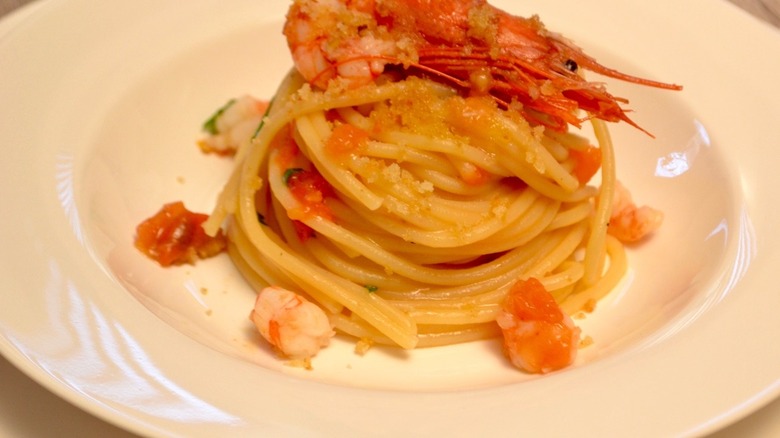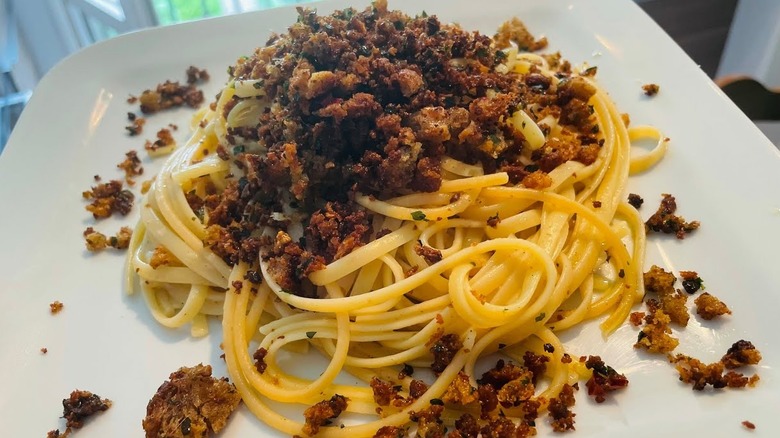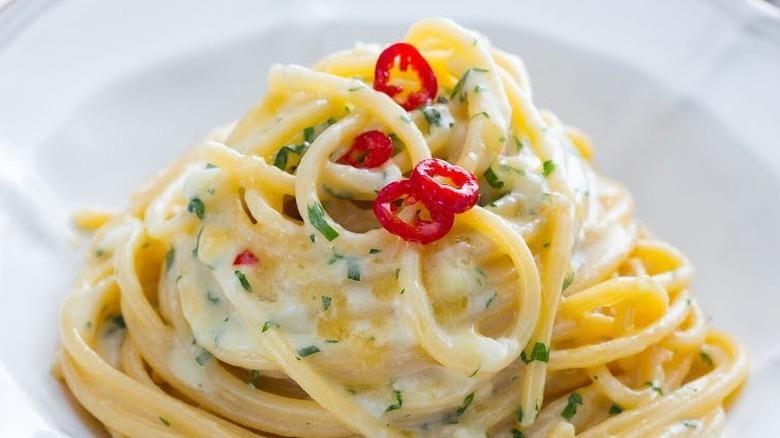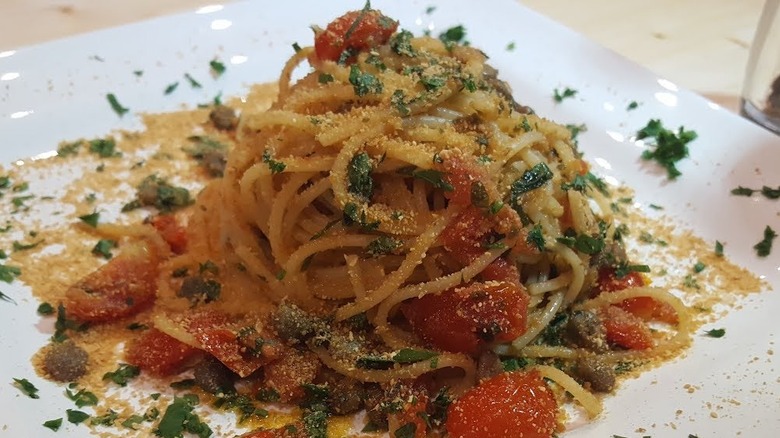20 Best Sicilian Pasta Dishes You Should Know About
From kissing dogs to canned classics, when pasta comes to mind, Italy naturally follows. A little-known fact that may shock you is that the pasta we know today actually originates from Italy's southern sibling, Sicily. It was imported by Arab colonizers at least 300 years before Marco Polo is believed to have brought it to mainland Italy from China. The earliest iterations included Arab spices and raisins but evolved over time with Sicilian cuisine's influence. Along with Arabs, over the years, it's been occupied by the Greeks, Normans, Spanish, and more. Each introduced foods and culinary ideas from their homeland, which makes Sicilian cuisine truly unique.
Pasta from Southern Italy is distinct from the rest of the country too. Unlike in the north, where they use soft flour and eggs, in Sicily, pasta is traditionally made using only durum wheat and water. Not only is Sicily the OG pasta maker, but it's also home to various crave-worthy styles. Known for its fishing culture, seafood plays a prominent role in Sicilian pasta. There's a wide variety of shapes and sizes used, from spaghetti and bucatini to local favorites like paccheri and anelletti. Trust us, pasta from the boot-shaped country isn't the only style you'll get a kick out of. Below is a list of the best Sicilian pasta dishes you should know about.
Pasta con pesce spada e menta (pasta with swordfish and mint)
If there's one ingredient the island of Sicily has an abundance of, it's fresh seafood. A classic pasta that's sure to satisfy spaghetti lovers and swashbucklers alike is pasta con pesce spada e menta, which in English translates to pasta with swordfish and mint. Meaty and hearty, swordfish flesh has a mild taste with a subtle sweetness that makes it great for those who don't enjoy a strong fishy flavor.
When blended with pasta, its thick yet tender consistency adds a nice mouthfeel. This swordfish, olives, capers, and mint recipe pairs perfectly with paccheri and can also be made using other large tubular styles like rigatoni, penne, and more. Finishing it with a piquant punch of chili flakes along with aromatic mint and fennel seeds will bring a nice contrast to the savory swordfish.
Pasta 'ncasciata (Sicilian baked pasta)
Another tried and true pasta recipe that'll make you pinch your fingers together is pasta 'ncasciata, or Sicilian baked pasta. It's a hearty stomach-filler that's great for feeding large groups, and for leftovers if you don't like sharing your savory favorites. Traditionally made in wood-fired ovens, pasta 'ncasciata has been around since Arabs occupied the island in the ninth century B.C.
In Sicily, you'll find 'ncasciata varies depending on which region you're in. In the southeast, Messina prepares it with a ragú of minced meat that's browned with onion and wine, while in the northwest, Palermo uses a zesty tomato sauce. There are many ways to enjoy this versatile dish. Ground beef is a reliably tasty meat option, and some recipes even add salty and smokey salami or cooked ham. If you're a fan of eggplant parmigiana and baked ziti, you'll love pasta 'ncasciata.
Spaghetti ai ricci di mare (spaghetti with sea urchin)
In Sicily's seafood-rich cuisine, an ancient classic that's grown to become a global go-to is spaghetti ai ricci di mare, also known as spaghetti with sea urchin. While strangely spine-y on the outside, inside, the urchin's flesh resembles a thick tongue and tastes similar to oyster, caviar, or salmon roe. These odd-looking underwater creatures come in a wide variety of colors, textures, and flavors, which is why this pasta can offer a wide range of delicious experiences.
A great summertime option, the sea urchin itself isn't cooked, but rather added to the pasta directly after, allowing its heat to infuse it with the urchin's flavor. When blended with pasta, it becomes a deliciously savory and zestful experience. You can even try it out for yourself with this spaghetti with sea urchin recipe from Los Angeles-based restaurant Bestia.
Couscous alla trapanese (couscous with trapanese)
Sicily's size and location made it a magnet for ambitious conquerors throughout history. There was an upside though; the influx of different cultural presences influenced Sicilian cuisine, helping it become more complex and diverse. Couscous was introduced when the small island came under Arab rule. In Sicily, it's most often paired with seafood, unlike how it's made in its North African motherland with meats and stews.
This pasta staple comes from Sicily's Trapani province and flavorfully melds couscous with a mix of fresh seafood. It's called couscous alla Trapanese, which can also mean couscous Trapani-style. If you enjoy hearty but healthy couscous topped with seasoned fish broth and the aroma of the Mediterranean, you should definitely check it out.
Pasta con le sarde (pasta with sardines)
Whether enjoyed in its simplest form or blended with a mouthwatering array of ingredients, Sicilian pasta can stand with the best of them. One of the earliest pasta recipes that grew to become a local staple was actually invented by Arab cooks.
Called pasta con le sarde (or pasta with sardines), story has it that the conquering General Eufemio needed to feed a hungry army, so he ordered his cooks to create a dish that combined ingredients native to Sicily mixed with pine nuts and saffron, which are flavors from their homeland. Mild-flavored with a subtle fishiness, sardines make this pasta salty and rich. It's cooked with licorice-like fennel and simmered with tomatoes and raisins, which adds a sweet touch.
Pasta alla norma (Pasta to the standard)
With a rich and varied history, there's an almost endless variety of Sicilian pasta to try. One of the most popular is pasta alla norma. It's made with short-cut pasta like rigatoni or campanelle and blended with toasted garlic, earthy fried eggplant, zesty tomatoes, and aromatic basil with a final sprinkle of creamy Grana Padano. Sicily's classic pasta has musical origins. It's believed that it was made during the opening night of a famous 19th-century opera named "Norma," composed by Vincenzo Bell.
That's only half the story though. Others believe that it was named after a reaction that Nino Mortoglio, another Sicilian composer, had to tasting eggplant pasta. "Chista è 'na vera Norma!" Mortoglio exclaimed, which means "This is a true Norma!" Regarding Bellini's "Norma" as a masterpiece, Mortoglio felt it was the best word to describe how perfect the eggplant pasta tasted.
Pesto alla trapanese (Sicilian pesto with almonds and tomatoes)
It's common in a region's culinary development that different approaches are invented for a type of food. For example, many varieties of pesto exist throughout Italy and its surrounding islands. While pesto alla genovese has garnered the most global exposure, other types use completely different ingredients and even come in different colors.
For example, pesto Modenese is white in color and made with a cured salami called lardo, Parmigiano Reggiano, garlic, rosemary, and black pepper. Sicily's pesto alla trapanese also differs from classic basil pesto. It uses almonds in place of pine nuts because of their prevalence on the island. It also includes Pachino cherry tomatoes and sometimes fresh mint leaves. Pesto alla trapanese is typically enjoyed with busiate pasta and finished with a dust of grated cheese or breadcrumbs.
Spaghetti al nero di seppia (spaghetti with cuttlefish ink)
Another unique Sicilian-style pasta that'll either pique your curiosity or send you running for the mountains is spaghetti al nero di seppia, which translates to spaghetti with cuttlefish ink. It's super savory, black-colored, and looks like a pasta recipe Tim Burton might've dreamt up. Spaghetti al nero di seppia gets its distinctive color and flavor from cuttlefish ink — it's silky and salty, carrying a flavor of fresh seawater and umami.
There are two ways to make this special Sicilian staple: mix the ink directly into the flour if you're making pasta from scratch, or add it to the sauce as it cooks. We recommend using a thin long-strand pasta like spaghetti or angel hair because it's great with buttery sauces like this one.
Lasagne cacate (Sicilian lasagna)
Nothing builds anticipation more than the aroma of freshly baked layers of cheesy goodness. If pasta sits at the top of Italy's culinary mountaintop, lasagna's peak still reaches impressive heights. Rich and scrumptious, it has everything you love about pasta, an extra helping of cheese, and can feed lots of people — lasagna is sheer perfection.
In Sicily, lasagna cacate is traditionally prepared on Christmas. It's enjoyed island-wide, yet mainly in Modica and Palermo. It's made using a ragù of chopped beef or pork, white wine, tomato sauce, and garlic, and topped with ricotta and grated pecorino cheese. While it may resemble your average lasagna, the local ingredients used make lasagna cacate uniquely Sicilian.
Pasta al pesto di pistacchi (pistacchio pasta)
Pistachios are commonly used in Sicilian cuisine. The Moors were the ones that introduced pistachios to Sicily. Today, it's harvested using the same traditional methods that the Moors used — one at a time and by hand. A first-course knockout that you should add to your culinary queue is pasta al pesto di pistacchi, or simply, pistachio pasta.
Creamy, aromatic, and nutty, the pistachio-infused pesto is the Sicilian version of the classic sauce. It also includes mint, which adds a surprisingly refreshing touch. Pasta al pesto di pistacchi is definitely a food you have to try in Sicily. Unlike the island's more complex pasta recipes, this one only takes a few minutes to make, so it's great when you're low on time.
Sicilian-style linguine
When you manage to get it just right, pasta is the perfect way to describe the power of simplicity. Some of the best pasta recipes are straightforward. All it takes is a few ingredients chosen with careful consideration mixed with a dash of epicuriosity, and voilà, nothing's im-pasta-ble. One easy on-to-go recipe is Sicilian-style linguine.
Filling yet not overly flavorful, it's an awesome midday quick fix and also a great late-night cure for hunger pangs. You just need olive oil, chopped garlic, a pinch of crushed red pepper flakes, kosher salt, and fresh parsley. You can cook it in under 10 minutes and finish it off with a sprinkle of toasted Italian breadcrumbs. Talk about instant gratification! Check out this Sicilian-style linguine recipe.
Maccheroni con salsiccia ragù (macaroni with ragù sausage)
Sauce and sausage are clearly a match made in heaven, as each begins with the same three letters. In Sicilian and Italian cuisine, they call the savory duo ragù alla salsiccia, otherwise known as sauce with sausage. It's traditionally slow-cooked with tomato purée, zesty onion and shallot, sweet carrots and fresh celery, garlic and herbs, olive oil, red wine, and, of course, sausage. It's a stomach-satisfying sauce that's normally enjoyed with macaroni during the week and on Sundays.
While the prep itself is quick and easy, you'll need to set some time aside to really give this recipe the cooking time it deserves. Not to fret, though; the taste of slow-cooked ragù only gets better with time.
Paccheri alla Eoliana
Another classic first-course Sicilian pasta dish is paccheri alla Eoliana, which can also be referred to as paccheri from the Aeolian Islands — a volcanic archipelago comprising seven islands off the coast of Northern Sicily. Fresh and light, paccheri alla Eoliana is often enjoyed during the summer months.
It's packed with quintessential Mediterranean ingredients like capers, anchovies, cherry tomatoes, garlic, oregano, and olive oil, along with black and green olives. Chili peppers are also added for an extra kick, while some recipes even include tuna. It's an affordable lunchtime dish that can easily feed a household. If your local grocery store doesn't carry paccheri, other tubular pasta like rigatoni and calamarata are perfectly suitable substitutes. You'll just have to call the recipe by a different name.
Pasta con tenerumi (pasta made with tenerumi)
You may have to visit an Italian market for this Sicilian delicacy, but if you're lucky enough to find it, the search will be totally worth it. Tenerumi are the leaves of Sicilian serpente zucchini and a summer staple at outdoor markets. Commonly sautéed with garlic like spinach or other popular leafy green vegetables, tenerumi is truly delicious in pasta.
Locally, the dish is aptly named pasta con tenerumi and is actually a hot soup made with ripe diced tomatoes, long zucchini strips, herbaceous and spicy caciocavallo ragusano cheese, olive oil, and garlic. As a soup-based pasta, it goes great with long-strand and shell-type noodles like spaghetti, fusilli, orecchiette, and cavatelli. Since tenerumi isn't widely available, chard works just fine as an alternative.
Anelletti al forno Siciliana (Sicilian-baked analletti)
A classic first-course offering in Sicilian cuisine, anelletti al forno Siciliano is traditionally prepared on Sundays or during holidays. Like many Sicilian pasta recipes, it's extremely versatile and fairly easy to make; all you need is a bit of baking time. It includes many of the same ingredients as lasagna, yet uses anelletti instead, which is the original circle-shaped pasta type.
Apart from fun-shaped noodles, the rich-bodied ragú is the real star of this delicious baked dish. Give it a flavorfully meaty taste by slow-cooking it with minced veal and pork for the best results. As mentioned, throughout the island you will come across many iterations, some of which include eggplant, hard-boiled eggs, ham, and pecorino cheese to name a few.
Maccheroni con speck e pistacchio (macaroni with speck and pistachio)
If you like creamy and toasted nut flavor, you'll love maccheroni con speck e pistachio, or macaroni with speck and pistachio. Only made using six simple ingredients, it's a tasty and protein-packed pasta perfect for dinner parties. Pistachio plays a major role in Sicilian cuisine and truly shines in this special pasta. Pistachio sauce is made with savory speck, which refers to any cured and smoked pork, diced onions, and heavy cream. As long as you have 20 minutes to spare, maccheroni con speck e pistachio is the time-saving meal you need.
When it comes to the best pasta pairing, medium-length styles like penne rigate, rigatoni, or cavatappi are best. If you prefer a long-strand type, fettuccine is great too.
Linguine rosso di mazara (red linguine)
Sicily's unique location in the Mediterranean has bestowed upon it some of the best ingredients. From its delectable Bronte pistachios to its ample supply of durum wheat, its climate is simply perfect for producing quality. Another ingredient that's unique to the island is red prawn from the port town of Mazara del Vallo. There, the red prawn is so beloved it's used in many dishes.
One particularly popular pasta is linguine rosso di Mazara (also known as red linguine). It tastes of the Mediterranean mixed together with savory salt and garlic, grassy olive oil, and tangy white wine. Whereas many Sicilian-style pastas are easy and affordable, in order to fully experience the delicious levels this dish can reach, you'll have to break the bank just a little. Cost aside, linguine rosso di Mazara is Sicilian perfection you absolutely must try.
Bucatini con aggiuche e muddica (pasta with anchovies and breadcrumbs)
Blending breadcrumbs into pasta is a great way to add some bite to its consistency. Beyond bite, if you make breadcrumbs from scratch, you can elevate the tasty toastiness even more. Bucatini con agguiche e muddica joins the list of Sicily's amazing breadcrumb-infused pasta.
It's made with salty anchovies, olive oil, sweet raisins, pine nuts, and earthy and floral saffron, then blended with bread bits. The combination of ingredients gives it a full-bodied flavor that deliciously balances savory and sweet. It's the contrasting flavors and textures that really make bucatini con aggiuche e muddica stand out. Although you'll find it most commonly made using bucatini, feel free to use any long-strand pasta of your liking.
Spaghetti alla carrettiera
The island of Sicily may be tiny, but when it comes to flavor, it's larger than life. A great example of that is a simple Sicilian-style pasta called spaghetti alla carrettiera. Its roots can be traced back to Sicilian wagoners who prepared it for lunch. In fact, the word carrettiera means wagoner or cart driver.
This no-frills sauce is made with grated tomatoes, minced garlic, chopped basil, olive oil, and red pepper flakes. In Sicily, you'll find many variations — some include pecorino siciliano and ricotta salata, while others leave out tomatoes entirely. That means it's versatile and affordable. Only requiring 30 minutes of your time, it's also a great pasta option for those with busy schedules.
Spaghettini alla Siracusana
Another long-strand Sicilian staple that's blended with breadcrumbs is spaghetti alla Siracusana. Originating from Syracuse, Sicily, it's made using almost the same ingredients as Bucatini con agguiche e muddica and pasta con le sarde; except it doesn't include raisins like the former, and does include breadcrumbs, unlike the latter.
Specific ingredients can sometimes vary, with some recipes using sardines and others calling for anchovies. Despite the fishy touch of sardines and anchovies, the flavor is balanced by a blend of tomatoes, olive oil, and garlic. Spaghetti alla Siracusana isn't a saucy pasta but has more than enough filling and flavor to please. Like many Sicilian-style pastas, it's an easy recipe to deposit in your culinary memory banks. Feel free to withdraw it whenever you're hungry for a taste of Sicily.
